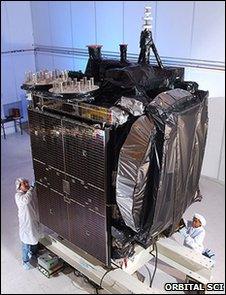'Zombie' satellite prompts orbital waltz
- Published

Galaxy-15 is slowly drifting eastwards
Two spacecraft are about to begin an unusual orbital dance above the Pacific Ocean to try to evade the interference from a third, failed satellite.
Control was lost of Intelsat's Galaxy-15 platform in April. It will not take commands from the ground and is in a drift towards neighbouring spacecraft.
The nearest, AMC-11, will now be eased out of its path, and some of its TV channels moved to a partner platform.
The pair's operator, SES World Skies, says customers should be unaffected.
The intricacy of the space choreography that is about to take place is thought to be unprecedented in the commercial telecommunications sector.
"We have to do slight manoeuvres with our spacecraft pretty regularly, but a manoeuvre of this nature and complexity - no, I'm not aware of anyone having done this before," said Alan Young, chief technology officer with SES World Skies.
"We need to make sure Americans can continue to watch their television. They love their TV and it's important," he told ҙуПуҙ«ГҪ News.
'Zombie' nickname
Galaxy-15 was launched in 2005 to re-distribute TV services to cable companies across North and Central America, and also to send navigation data to aeroplanes to improve the accuracy of their GPS receivers.
On 5 April, it experienced a major fault and its services were switched to a back-up spacecraft. Engineers have not yet established the cause, but damage from a solar storm is one possibility being investigated.
Although Intelsat cannot talk to Galaxy-15, its electronics payload remains fully functional, and it is capable of re-transmitting on full power any signal it receives.
This means that if Galaxy-15 were to get too close to other telecommunications spacecraft, it could start re-transmitting their signals and seriously interfering with their services.
This "dead-but-alive" condition has earned the Intelsat platform the unfortunate nick-name of "zombie-sat" in some quarters.
Normally positioned at 133 degrees West, and some 36,000km above the Pacific, the satellite is now drifting east into the slot occupied by AMC-11, a satellite operated by competitor SES World Skies.
To ensure its TV customers experience no loss or degradation of service, SES plans on Tuesday to initiate a drift in AMC-11 to match that of Galaxy-15. It has also already commanded a second satellite, SES-1, to come in behind the damaged platform.
Services will then be juggled between the two SES satellites until Galaxy-15 passes through the orbital slot and AMC-11 can return to its normal position and duties.
"We've moved customers on AMC-11 on to a very large uplink antenna," explained Mr Young.
"This means we can very finely discriminate between the two spacecraft so that we can direct all of the energy into AMC-11 and as little energy as possible into Galaxy-15. If you don't put anything into Galaxy-15, you won't get anything out."
Intelsat told ҙуПуҙ«ГҪ News its engineers would continue to try to regain control of Galaxy-15, whilst co-operating fully with other operators to minimise disruption.
Collisions with other satellites are highly unlikely. As it passes through other orbital slots, Galaxy-15 should still be separated from nearby spacecraft by many kilometres.
Ultimately, it is expected that the Intelsat platform will lose the ability to point its solar panels at the Sun and experience total power failure. This could take some months.
It should end its days in one of the gravity "sweetspots", or libration points, where orbital debris has a tendency to aggregate.